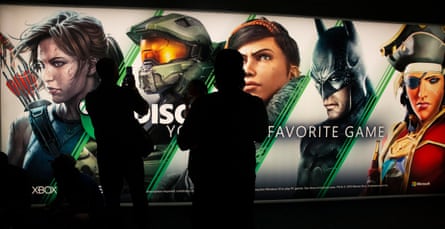Despite the absence of Sony PlayStation, this year’s annual Electronic Entertainment Expo in Los Angeles delivered the usual whirlwind of new game announcements, trailers, marketing bluster and performative fandom. For years the entire thing has been streamed on YouTube, Twitch and half the world’s gaming websites, everything from showy press conferences to long demonstrations, transforming the event from a games industry conference to a kind of mid-year Christmas for both game marketers and enthused players watching at home (or paying around $1,000 to attend in person).
So far, so expected. This is what E3 is now, and though the sense of mystery and anticipation has dimmed significantly in this age of instant streaming, Twitter hot-takes, online leaks and teaser trailers for teaser trailers, there’s still a thrill to it.
But while the event stays the same, behind the scenes the games industry is changing. This year’s E3 has made clear that video game consoles, with their cyclical generations and competing suites of exclusive games, are changing rapidly and are on their way to becoming obsolete.
Here’s how things used to work. Every three to five years, there would be a new box announced with great aplomb. It would play new, better-looking and more ambitious games, and if you wanted to play them, you would buy the new box. Now, in this transitional period where games consoles are starting to work more like different models of smartphone, Microsoft has just announced a new console – but if you want to play, say, Halo Infinite, you don’t have to buy Project Scarlett. You could also play it on your old Xbox One or even on your phone, streamed from the cloud. The cloud is a thing now.

Microsoft will not be drawn on whether Project Scarlett is a generational leap – a console that can play things that are impossible on Xbox One – or whether it will have exclusive games. What does a new console mean when it doesn’t come along with new games that push technological boundaries that previous consoles couldn’t? Or are those games coming, just not right away?
Equally unclear is how the process of buying a video game is changing.From physical discs to digital downloads and streaming access: right now we appear to have a mix of all three. You could pay £50 or so for Halo Infinite in a shop or online, but you could also get it with your Xbox Game Pass subscription, which is different from your Xbox Live Gold membership. Don’t worry, though – Xbox Game Pass Ultimate encompasses both.
This complexity is by no means exclusive to Microsoft. Google’s new Stadia streaming service also comes packaged with a maddening lack of clarity. There’s a $9.99 monthly subscription but most games will cost more on top. And then there’s Ubisoft’s newly announced Uplay+, a $14.99 subscription service that offers access to all the publisher’s newest games as well as a catalogue of 100 older ones, partnered with Stadia. It’s looking like the next few years of gaming are going to involve a lot of annoying-to-cancel direct debits.

An obsession (and expected fluency) with technical specifications has long limited video games’ broader appeal and it is strange to see the industry simultaneously moving towards and away from it. On the one hand, we have streaming services that aim to get rid of all the technical jargon that comes with gaming on consoles and PC, but we’ve also got two powerful new machines on the horizon from Sony and Microsoft, and both companies are talking up the specs and claiming that they will usher in a new age of seamless play.
This makes the message very mixed. Who cares how many teraflops of computing power your console has when you can stream games to your TV instead, offloading all the expensive computational work to a server miles away? But also, here’s a new box with Radeon RDNA graphics architecture and support for real-time hardware-accelerated ray tracing.
Meanwhile in the other corner, Nintendo is still making and marketing games like it’s 2006 and ignoring what everyone else is doing. We’ve got a neat, successful console, a Luigi game about a haunted house, a remake of a Zelda game from 1992 and a bunch of games about robots from Japan. And no subscription services. In the years to come, such simplicity may become a strong marketing line: being on the cutting edge has its disadvantages.
With both Project Scarlett and the PlayStation 5 likely to come out next year (the next Xbox is slated for the holiday season), clarity must surely come. For now, I’m wondering whether to start saving for a new games console or for the seven expensive subscriptions I might need to actually play anything on it.

